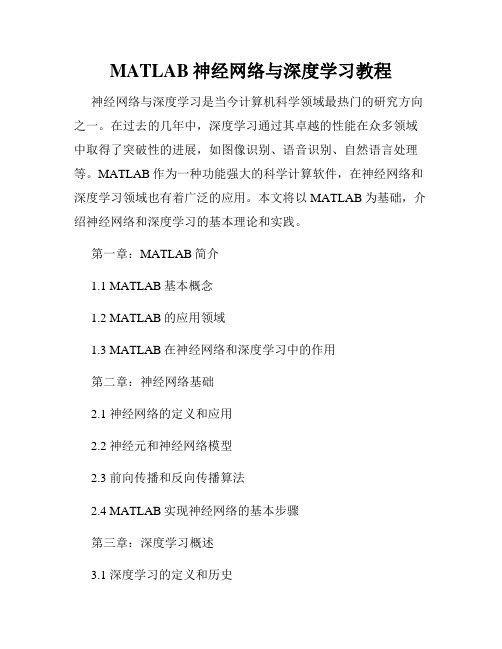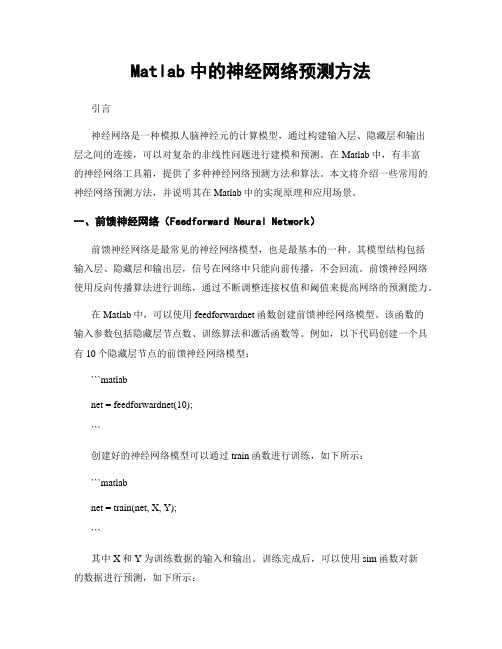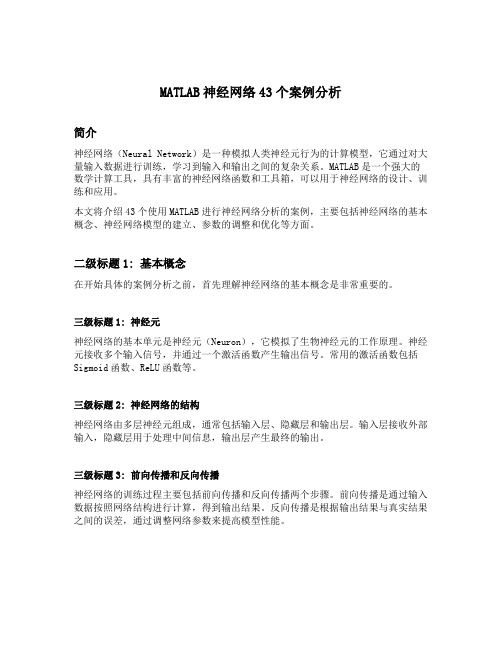MATLAB神经网络及其应用
在Matlab中实现神经网络的方法与实例

在Matlab中实现神经网络的方法与实例神经网络是一种模拟人类大脑神经系统的计算模型,它能够通过学习数据的模式和关联性来解决各种问题。
在计算机科学和人工智能领域,神经网络被广泛应用于图像识别、自然语言处理、预测等任务。
而Matlab作为一种功能强大的科学计算软件,提供了一套完善的工具箱,可以方便地实现神经网络的建模和训练。
本文将介绍在Matlab中实现神经网络的方法与实例。
首先,我们会简要介绍神经网络的基本原理和结构,然后详细讲解在Matlab中如何创建并训练神经网络模型,最后通过几个实例展示神经网络在不同领域的应用。
一、神经网络的原理和结构神经网络模型由神经元和它们之间的连接构成。
每个神经元接收输入信号,并通过权重和偏置进行加权计算,然后使用激活函数对结果进行非线性变换。
这样,神经网络就能够模拟复杂的非线性关系。
常见的神经网络结构包括前馈神经网络(Feedforward Neural Network)和循环神经网络(Recurrent Neural Network)。
前馈神经网络是最基本的结构,信号只能向前传递,输出不对网络进行反馈;而循环神经网络具有反馈连接,可以对自身的输出进行再处理,适用于序列数据的建模。
神经网络的训练是通过最小化损失函数来优化模型的参数。
常用的训练算法包括梯度下降法和反向传播算法。
其中,梯度下降法通过计算损失函数对参数的梯度来更新参数;反向传播算法是梯度下降法在神经网络中的具体应用,通过反向计算梯度来更新网络的权重和偏置。
二、在Matlab中创建神经网络模型在Matlab中,可以通过Neural Network Toolbox来创建和训练神经网络模型。
首先,我们需要定义神经网络的结构,包括输入层、隐藏层和输出层的神经元数量,以及每个神经元之间的连接权重。
例如,我们可以创建一个三层的前馈神经网络模型:```matlabnet = feedforwardnet([10 8]);```其中,`[10 8]`表示隐藏层的神经元数量分别为10和8。
MATLAB神经网络与深度学习教程

MATLAB神经网络与深度学习教程神经网络与深度学习是当今计算机科学领域最热门的研究方向之一。
在过去的几年中,深度学习通过其卓越的性能在众多领域中取得了突破性的进展,如图像识别、语音识别、自然语言处理等。
MATLAB作为一种功能强大的科学计算软件,在神经网络和深度学习领域也有着广泛的应用。
本文将以MATLAB为基础,介绍神经网络和深度学习的基本理论和实践。
第一章:MATLAB简介1.1 MATLAB基本概念1.2 MATLAB的应用领域1.3 MATLAB在神经网络和深度学习中的作用第二章:神经网络基础2.1 神经网络的定义和应用2.2 神经元和神经网络模型2.3 前向传播和反向传播算法2.4 MATLAB实现神经网络的基本步骤第三章:深度学习概述3.1 深度学习的定义和历史3.2 深度学习的基本框架3.3 深度学习的优势和挑战3.4 MATLAB在深度学习中的应用第四章:卷积神经网络 (CNN)4.1 CNN的基本原理和结构4.2 CNN在图像识别中的应用4.3 搭建和训练CNN的步骤4.4 MATLAB实现CNN的案例分析第五章:循环神经网络 (RNN)5.1 RNN的基本原理和结构5.2 RNN在自然语言处理中的应用5.3 搭建和训练RNN的步骤5.4 MATLAB实现RNN的案例分析第六章:深度学习模型的训练和优化6.1 数据预处理和特征工程6.2 激活函数和损失函数的选择6.3 参数初始化和正则化方法6.4 MATLAB实现深度学习模型的训练和优化技巧第七章:深度学习模型的评估和应用7.1 模型评估指标7.2 混淆矩阵和ROC曲线7.3 深度学习在实际应用中的案例7.4 MATLAB实现深度学习模型的评估和应用第八章:MATLAB深度学习工具箱8.1 神经网络工具箱的概述8.2 深度学习工具箱的概述8.3 MATLAB深度学习工具箱的使用方法8.4 MATLAB深度学习工具箱的案例展示总结:本文以MATLAB为基础,全面介绍了神经网络和深度学习的理论与实践。
基于MATLAB的RBF神经网络建模及应用

第27卷 第2期大庆师范学院学报Vol.27 No.2 2007年4月JOURNAL OF DAQ I N G NOR MAL UN I V ERSI TY Ap ril,2007基于MAT LAB的RBF神经网络建模及应用王艳芹,张 维(大庆师范学院物理与电气信息工程系,黑龙江大庆163712)摘 要:MAT LAB中的神经网络工具箱是进行神经网络系统分析与设计的有力工具。
RBF神经网络以其计算量小,学习速度快,不易陷入局部极小等诸多优点为系统辨识与建模提供了一种有效的手段。
将二者结合起来,解决了油田试井系统中压力值的建模问题,取得了令人满意的结果。
关键词:RBF神经网络;MAT LAB;试井系统作者简介:王艳芹(1979-),女,黑龙江海伦人,大庆师范学院物理与电气信息工程系教师,从事神经网络辨识与建模研究。
中图分类号:TP273 文献标识码:A 文章编号:1006-2165(2007)02-0118-03 收稿日期:2007-01-220引言人工神经网络作为一门新兴学科在非线性系统的建模与辨识中得到了广泛的应用[1]。
目前应用最广泛、直观、易理解的是基于误差反向传播算法的多层前向神经网络,简称BP(Err or Back Pr opagati on)网络,但该网络存在着收敛速度慢、易陷入局部极小及隐含层结点个数不易确定等缺陷。
近些年备受关注的另一种前向神经网络———径向基函数(Radial Basis Functi on,简记RBF)神经网络有效地解决了上述问题。
在人工神经网络的功能实现上,与传统的利用Basic、Fortran、C等语言编程相比,直接应用第四代计算机语言MAT LAB的神经网络工具箱更加简便易行。
MAT LAB是由美国M ath works公司发布的面向科学计算、数据可视化以及交互式程序设计的高级语言,其诸如小波分析、鲁棒控制、模糊逻辑、神经网络等丰富的工具箱代表了当今一流专家学者在这些领域的前沿工作[2]。
Matlab中的神经网络预测方法

Matlab中的神经网络预测方法引言神经网络是一种模拟人脑神经元的计算模型,通过构建输入层、隐藏层和输出层之间的连接,可以对复杂的非线性问题进行建模和预测。
在Matlab中,有丰富的神经网络工具箱,提供了多种神经网络预测方法和算法。
本文将介绍一些常用的神经网络预测方法,并说明其在Matlab中的实现原理和应用场景。
一、前馈神经网络(Feedforward Neural Network)前馈神经网络是最常见的神经网络模型,也是最基本的一种。
其模型结构包括输入层、隐藏层和输出层,信号在网络中只能向前传播,不会回流。
前馈神经网络使用反向传播算法进行训练,通过不断调整连接权值和阈值来提高网络的预测能力。
在Matlab中,可以使用feedforwardnet函数创建前馈神经网络模型。
该函数的输入参数包括隐藏层节点数、训练算法和激活函数等。
例如,以下代码创建一个具有10个隐藏层节点的前馈神经网络模型:```matlabnet = feedforwardnet(10);```创建好的神经网络模型可以通过train函数进行训练,如下所示:```matlabnet = train(net, X, Y);```其中X和Y为训练数据的输入和输出。
训练完成后,可以使用sim函数对新的数据进行预测,如下所示:```matlabY_pred = sim(net, X_pred);```Y_pred为预测结果,X_pred为待预测的输入数据。
二、递归神经网络(Recurrent Neural Network)递归神经网络是另一种常见的神经网络模型,不同于前馈神经网络,递归神经网络允许信号在网络中进行循环传播,使得模型可以处理序列数据和时间序列数据。
递归神经网络拥有记忆功能,可以通过上一时刻的输出来影响当前时刻的输出。
在Matlab中,可以使用narnet函数创建递归神经网络模型。
该函数的输入参数包括隐藏层节点数、训练算法和激活函数等。
matlab神经网络43个案例分析

MATLAB神经网络43个案例分析简介神经网络(Neural Network)是一种模拟人类神经元行为的计算模型,它通过对大量输入数据进行训练,学习到输入和输出之间的复杂关系。
MATLAB是一个强大的数学计算工具,具有丰富的神经网络函数和工具箱,可以用于神经网络的设计、训练和应用。
本文将介绍43个使用MATLAB进行神经网络分析的案例,主要包括神经网络的基本概念、神经网络模型的建立、参数的调整和优化等方面。
二级标题1: 基本概念在开始具体的案例分析之前,首先理解神经网络的基本概念是非常重要的。
三级标题1: 神经元神经网络的基本单元是神经元(Neuron),它模拟了生物神经元的工作原理。
神经元接收多个输入信号,并通过一个激活函数产生输出信号。
常用的激活函数包括Sigmoid函数、ReLU函数等。
三级标题2: 神经网络的结构神经网络由多层神经元组成,通常包括输入层、隐藏层和输出层。
输入层接收外部输入,隐藏层用于处理中间信息,输出层产生最终的输出。
三级标题3: 前向传播和反向传播神经网络的训练过程主要包括前向传播和反向传播两个步骤。
前向传播是通过输入数据按照网络结构进行计算,得到输出结果。
反向传播是根据输出结果与真实结果之间的误差,通过调整网络参数来提高模型性能。
二级标题2: 案例分析三级标题4: 案例1: 图像分类本案例通过使用神经网络和MATLAB工具箱,对手写数字图像进行分类。
首先,将图像数据转化为向量形式,并通过网络进行训练。
然后,将训练好的网络用于分类未知图像,并评估分类性能。
三级标题5: 案例2: 时序预测本案例使用神经网络来预测时间序列数据。
通过对历史数据进行训练,建立时序模型,并利用该模型来预测未来的数据。
通过调整网络结构和参数,提高预测准确性。
三级标题6: 案例3: 异常检测本案例利用神经网络进行异常检测。
通过对正常数据进行训练,建立正常模型,并使用该模型检测异常数据。
通过调整网络的灵敏度和阈值,提高异常检测的性能。
MATLAB中常见的神经网络模型介绍

MATLAB中常见的神经网络模型介绍神经网络是一种模拟生物神经网络工作机制的数学模型。
它由许多人工神经元组成,这些神经元之间存在着连接,通过学习和优化,神经网络能够模拟和处理各种复杂的输入输出关系。
在MATLAB中,有许多常见的神经网络模型可供使用,下面将介绍其中几个。
一、前馈神经网络(Feedforward Neural Network)前馈神经网络是最常见和基本的神经网络模型之一。
它的结构由多层神经元组成,每一层的神经元与下一层的神经元完全连接,信号只能从输入层传输到输出层,不会反向传播。
前馈神经网络适用于分类、回归等问题。
在MATLAB中,创建一个前馈神经网络可以使用“feedforwardnet”函数。
可以设置隐藏层的大小、传递函数类型、训练算法等参数。
通过训练数据,可以使用MATLAB提供的各种优化算法进行网络模型的训练和预测。
二、循环神经网络(Recurrent Neural Network)循环神经网络是一种具有回路结构的神经网络模型。
它的每一个神经元都接受来自上一时刻输出的信号,并将当前的输入和上一时刻的输出作为输入,进行计算。
循环神经网络能够处理具有时序关系的数据,例如序列预测、语言模型等。
在MATLAB中,创建一个循环神经网络可以使用“layrecnet”函数。
可以设置回路层的大小、传递函数类型、训练算法等参数。
通过训练数据,同样可以使用MATLAB提供的优化算法进行网络模型的训练和预测。
三、自组织映射网络(Self-Organizing Map)自组织映射网络是一种无监督学习的神经网络模型。
它通过将输入数据投影到一个低维的节点空间中,并学习节点之间的拓扑结构。
自组织映射网络在数据聚类、特征提取等领域有广泛的应用。
在MATLAB中,创建一个自组织映射网络可以使用“selforgmap”函数。
可以设置节点空间的维度、拓扑结构、距离度量等参数。
通过输入数据,可以使用MATLAB提供的训练算法进行网络模型的训练和预测。
Matlab技术神经网络模型
Matlab技术神经网络模型一、引言在当今快速发展的信息化时代,神经网络模型被广泛应用于各个领域,如图像识别、语音处理、数据挖掘等。
Matlab作为一种功能强大的科学计算软件,提供了丰富的工具和函数,能够帮助研究人员和工程师设计、实现和优化神经网络模型。
本文将介绍Matlab技术在神经网络模型中的应用,探讨其优势和局限性。
二、Matlab与神经网络模型1. Matlab的优势Matlab作为一种高级编程语言,具有简洁、易读的语法,使得编写和调试神经网络模型变得更加简单。
同时,Matlab提供了丰富的函数库,包括多种神经网络工具箱,如神经网络工具箱(Neural Network Toolbox)、深度学习工具箱(Deep Learning Toolbox)等。
这些工具箱内置了大量的函数和算法,方便用户快速搭建并训练神经网络模型。
2. Matlab在神经网络模型中的应用Matlab提供了多种神经网络模型的实现方法,包括前馈神经网络(Feedforward Neural Network)、循环神经网络(Recurrent Neural Network)和深度神经网络(Deep Neural Network)等。
用户可以根据自己的需求选择合适的网络结构,并使用Matlab 提供的函数进行定义和训练。
在前馈神经网络模型中,Matlab提供的函数可以帮助用户构建网络的拓扑结构,并设置激活函数、损失函数和优化算法等参数。
用户可以通过调整这些参数来优化模型的性能。
此外,Matlab还提供了可视化工具,可帮助用户直观地理解神经网络的结构和训练过程。
在循环神经网络模型中,Matlab提供了LSTM(Long Short-Term Memory)、GRU(Gated Recurrent Unit)等常用的循环单元,以及Seq2Seq(Sequence to Sequence)结构等。
这些函数与演算法相结合,可以有效解决时间序列数据的处理问题,如语音识别、机器翻译等。
Matlab中的神经网络和深度学习技术
Matlab中的神经网络和深度学习技术神经网络和深度学习是近年来备受关注的研究领域。
作为一种模拟人脑神经系统的计算模型,神经网络可以学习和推断复杂的模式和关系。
而深度学习则是神经网络的一个分支,通过构建多层次的神经网络结构,可以更好地提取和理解数据中的特征。
Matlab作为一种强大的数学建模和数据处理软件,提供了丰富的函数和工具箱,能够支持神经网络和深度学习的研究和应用。
本文将探讨Matlab中的神经网络和深度学习技术的应用和发展趋势。
1. 神经网络的基本原理和应用神经网络模型将人脑的神经元和突触连接关系抽象成一个由多个层次组成的网络结构。
输入层接收原始数据,处理层负责特征提取和数据转换,输出层生成最终的结果。
通过调整网络的权重和偏置,神经网络可以自动学习和训练,实现对数据的分类、回归等任务。
在Matlab中,可以使用Neural Network Toolbox这个工具箱实现神经网络的建模和训练。
该工具箱提供了多种神经网络类型和算法,包括前馈神经网络、循环神经网络、自适应神经网络等。
用户可以根据具体问题选择合适的网络结构和参数配置,并利用训练集进行网络的训练和优化。
神经网络广泛应用于图像识别、语音识别、自然语言处理等领域。
在图像识别中,通过训练神经网络,可以实现对图像中物体、人脸等目标的自动识别和分类。
在语音识别中,神经网络可以对声音信号进行特征提取和模式匹配,实现语音指令的识别。
在自然语言处理中,通过训练神经网络,可以实现中文分词、情感分析等任务。
2. 深度学习的发展和应用深度学习是近年来神经网络领域的重要发展方向。
它通过构建多层次的神经网络模型,可以实现对数据特征的更精确提取和建模。
深度学习结合了神经网络和大规模数据集,借助于深度学习框架,如TensorFlow、PyTorch等,可以高效地进行深度学习任务。
在Matlab中,除了Neural Network Toolbox,还有Deep Learning Toolbox可以支持深度学习的建模和应用。
神经网络Matlab应用
确定信息的表达方式
将研究领域的数据抽象成神经网络可以接受的数据形式, 将研究领域的数据抽象成神经网络可以接受的数据形式, 实际存在的几种形式: 实际存在的几种形式: *数据样本已知 *数据样本间的关系不明确 *输入或输出的模式是连续的或是离散 输入或输出的数据按模式模式进行分类,可分为平移、 *输入或输出的数据按模式模式进行分类,可分为平移、旋 转、伸缩等模式形式 *数据样本的预处理 将数据样本分为训练样本和 *将数据样本分为训练样本和测试样本
基于神经网络的Matlab应用 基于神经网络的Matlab应用 Matlab
管科经网络模型中主要应用 Matlab神经网络工具箱的在神经网络模型中主要应用
• 函数逼近和模型拟合 • 信息处理和预测 • 神经网络控制 • 故障诊断 ***
在实际应用中,面对一个具体的问题时, 在实际应用中,面对一个具体的问题时,首先要分析 用神经网络求解问题的性质,然后依据问题特点, 用神经网络求解问题的性质,然后依据问题特点,确 定神经网络模型,最后对网络进行训练、仿真等. 定神经网络模型,最后对网络进行训练、仿真等.
MATLAB中的神经网络算法详解
MATLAB中的神经网络算法详解一、引言神经网络是一种模拟生物神经元工作原理的计算模型,具有模式识别、分类、优化等各种应用。
在日常生活和工业生产中,我们经常会遇到需要处理大量数据并进行复杂计算的问题。
而神经网络算法正是为了解决这些问题而设计的。
MATLAB作为一种功能强大的数值计算软件,提供了丰富的神经网络算法库。
本文将通过对MATLAB中神经网络算法的详细解释,展示其在数据处理和分析方面的广泛应用。
二、神经网络基础1. 神经网络结构神经网络由神经元(或称为节点)和连接这些神经元的权重组成。
一般而言,神经网络通过层与层之间的连接来进行信息传递。
常见的神经网络结构包括前馈神经网络和循环神经网络。
前馈神经网络是最常见的神经网络结构之一。
它的信息传递是单向的,不会存在回路。
循环神经网络则允许信息在网络中进行循环传递,这使得它能够处理具有时序特点的数据。
2. 权重与偏置在神经网络中,每个连接都有一个权重,用来表示两个神经元之间的关系强度。
权重值可以是正、负,以及接近于零的任意值。
权重值越大,表示两个神经元之间的相关性越强。
除了权重,神经网络中还存在一个偏置值,用来表示神经元的激活阈值。
3. 激活函数激活函数决定了神经元的输出结果。
常见的激活函数包括Sigmoid函数、ReLU函数等。
激活函数的引入可以使神经网络模型拟合非线性问题。
三、MATLAB中的神经网络算法1. 建立神经网络模型在MATLAB中,可以利用神经网络工具箱来建立神经网络模型。
首先,我们需要确定网络的架构,包括输入层的节点数、隐藏层的节点数、输出层的节点数等。
然后,我们可以使用MATLAB提供的函数创建一个神经网络对象,设定各层的节点数以及激活函数类型。
2. 训练神经网络神经网络的训练过程是一个优化问题。
训练过程中,我们需要定义一个损失函数来衡量模型在训练数据上的拟合程度。
MATLAB提供了多种优化算法,如反向传播算法、遗传算法等,用于调整网络中的权重和偏置,从而最小化损失函数。
- 1、下载文档前请自行甄别文档内容的完整性,平台不提供额外的编辑、内容补充、找答案等附加服务。
- 2、"仅部分预览"的文档,不可在线预览部分如存在完整性等问题,可反馈申请退款(可完整预览的文档不适用该条件!)。
- 3、如文档侵犯您的权益,请联系客服反馈,我们会尽快为您处理(人工客服工作时间:9:00-18:30)。
参数说明
The learning function BLF can be either of the backpropagation learning functions such as LEARNGD, or LEARNGDM.
P - NixTS cell array, each element P{i,ts} is an RixQ matrix. T - NtxTS cell array, each element P{i,ts} is an VixQ matrix. Pi - NixID cell array, each element Pi{i,k} is an RixQ matrix. Ai - NlxLD cell array, each element Ai{i,k} is an SixQ matrix. Y - NOxTS cell array, each element Y{i,ts} is an UixQ matrix. E - NtxTS cell array, each element P{i,ts} is an VixQ matrix. Pf - NixID cell array, each element Pf{i,k} is an RixQ matrix. Af - NlxLD cell array, each element Af{i,k} is an SixQ matrix.
TRAIN(NET,P,T,Pi,Ai) takes,
NET - Network. P - Network inputs. T - Network targets, default = zeros. Pi - Initial input delay conditions, default = zeros. Ai - Initial layer delay conditions, default = zeros. VV - Structure of validation vectors, default = []. TV - Structure of test vectors, default = [].
% in(:,1)=c1; % in(:,2)=c2; % in(:,3)=c3; % in(:,4)=c4; % in(:,5)=c5; % in(:,6)=c6; % in(:,7)=c7; % in(:,8)=c8; %
续
% c1_max=max(c1); % c5_max=max(c5);
PR - Rx2 matrix of min and max values for R input elements. Si - Size of ith layer, for Nl layers. TFi - Transfer function of ith layer, default = 'tansig'. BTF - Backprop network training function, default = 'trainlm'. BLF - Backprop weight/bias learning function, default =
5 实现
数据处理和准备
把WORD数据转换成TXT文件格式 利用dlmread读取数据 是否进行归一化处理?
生成网络
为调用newff命令做好各种准备
pr矩阵的形成 网络结构确定:网络层数以及每层的神经元
个数 每一层的传输函数的确定
注意参数的含义
进行网络训练
为调用train命令进行数据准备
% c4_max=max(c4); % c8_max=max(c8);
c4_min=min(c4); c8_min=min(c8);
续
pr=[c1_min,c1_max;c2_min, c2_max;c3_min,c3_max;c4_ min,c4_max;c5_min,c5_max; c6_min,c6_max;c7_min,c7_ max;c8_min,c8_max;];
Syntax
[net,tr,Y,E,Pf,Af] = train(NET,P,T,Pi,Ai,VV,TV)
Description
TRAIN trains a network NET according to NET.trainFcn and NET.trainParam.
输入参数说明
MATLAB中的神经网络及其应 用:以BP为例
主讲:王茂芝 副教授
1 一个预测问题
已知:一组标准输入和输出数据(见附件) 求解:预测另外一组输入对应的输出 背景:略
2 BP网络
3 MATLAB中的newff命令
NEWFF Create a feed-forward backpropagation network.
输入样本的确定 标准输出的确定 网络训练参数(次数)的确定
net. trainParam.epochs=100
调用网络训练命令:net=train(net,p,t);
进行输出模拟
调用y=sim(net,p)进行输出模拟 画图进行对比
查看网络参数及权值
net net参数引用和查看
Syntax
net = newff net = newff(PR,[S1 S2...SNl],{TF1
TF2...TFNl},BTF,BLF,PF)
命令newff中的参数说明
NET = NEWFF creates a new network with a dialog box.
NEWFF(PR,[S1 S2...SNl],{TF1 TF2...TFNl},BTF,BLF,PF) takes,
输出参数说明
and returns,
NET - New network. TR - Training record (epoch and perf). Y - Network outputs. E - Network errors. Pf - Final input delay conditions. Af - Final layer delay conditions.
说明
Note that T is optional and need only be used for networks that require targets.
Pi and Pf are also optional and need only be used for networks that have input or layer delays.
p=in'; t=out';
net.trainParam.epochs=100; net=train(net,p,t); y=sim(net,p);
The performance function can be any of the differentiable performance functions such as MSE or MSEREG.
4 MATLAB中的train命令
TRAIN Train a neural network.
输入参数数据结构说明
The cell array format is easiest to describe. It is most convenient for networks with multiple inputs and outputs, and allows sequences of inputs to be presented:
输入参数数据结构说明
Where:
Ni = net.numInputs Nl = net.numLayers Nt = net.numTargets ID = net.numInputDelays LD = net.numLayerDelays TS = number of time steps Q = batch size Ri = net.inputs{i}.size Si = yers{i}.size Vi = net.targets{i}.size
'learngdm'. PF - Performance function, default = 'mse'.
and returns an N layer feed-forward backprop network.
参数说明
The transfer functions TFi can be any differentiable transfer function such as TANSIG, LOGSIG, or PURELIN.
6 预测及分析
sim输出 重新训练并sim输出 画图对比
7 程序实现
clc clear all clear net load data; load data_pre;
c1=in(:,1); c2=in(:,2); c3=in(:,3); c4=in(:,4); c5=in(:,5); c6=in(:,6); c7=in(:,7); c8=in(:,8);
The training function BTF can be any of the backprop training functions suபைடு நூலகம்h as TRAINLM, TRAINBFG, TRAINRP, TRAINGD, etc.
参数说明
*WARNING*: TRAINLM is the default training function because it is very fast, but it requires a lot of memory to run. If you get an "out-of-memory" error when training try doing one of these:
